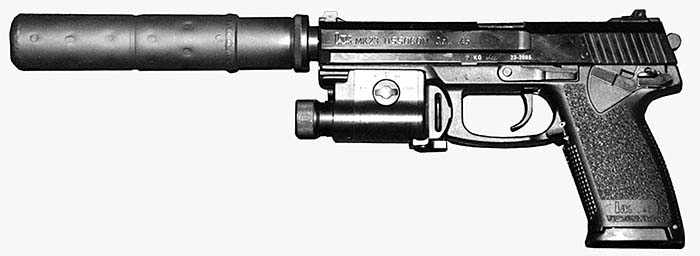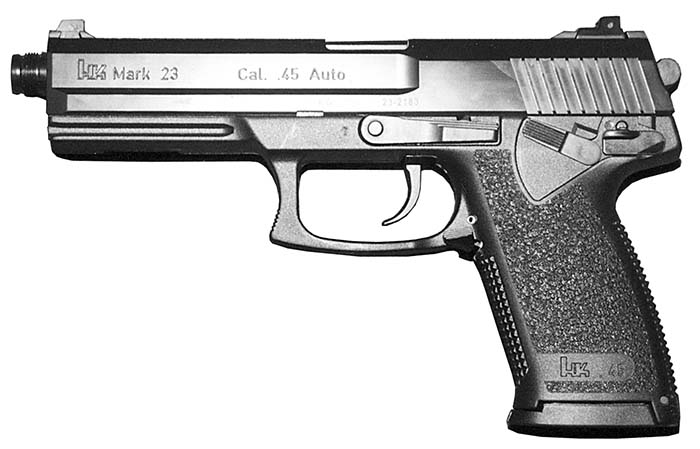By Charles Q. Cutshaw
In Part I of this article(SAR Volume 1 Number 12), the author followed the early development of the USP pistol series. In this final edition, he presents the present tactical forms, as in the USP Tactical pistol and the OHG, or Offensive HandGun.
The Mark 23 Mod 0 USSOCOM Offensive Handgun
As we have already mentioned, the USP was already under development when the US Special Operations Command (USSOCOM) issued its requirement for an offensive handgun, at the time designated the Offensive Handgun Weapon System (OHWS). While the OHWS designation was used throughout the development of the pistol the OHWS became MK 23 Mod 0 USSOCOM Pistol when the pistol was officially adopted and type classified. Pistols for civilian sale are designated Mark 23 and so marked on the slide rather than “MK23 USSOCOM.” We will use the designation Mark 23 to avoid confusion and to maintain continuity.
Before entering into the history of the Mark 23, we should examine the term “offensive handgun” or “offensive pistol,” which to many is an oxymoron. The handgun has traditionally been the weapon of last resort or a backup to one’s primary weapon, and hence not truly a weapon of preference, at least in military terms. The handgun is traditionally a defensive weapon, used in the military by officers as a backup and by others such as machine gun crewmen as a secondary weapon. While the pistol may be the law enforcement officer’s primary weapon, it is still considered essentially a defensive weapon.
Nonetheless, the handgun has been used offensively by the military. The first notable instance of this was the LeMat revolver used by Confederate cavalry in the War Between the States. This large 40-caliber revolver held nine shots, and its cylinder revolved around a 16-gauge shotgun barrel. All in all, the LeMat was a formidable weapon for its time. Confederate cavalrymen preferred to carry two of these big revolvers and used them for close combat in lieu of their sabers. A more recent offensive use of the handgun was in Vietnam by “tunnel rats” who searched Viet Cong tunnels armed with only a handgun and a flashlight. The essence of both operational uses of the pistol was the fact that it was used to carry the battle to the enemy rather than to defend against him. This single characteristic defines the essential difference between the offensive and defensive use of the handgun. While almost any handgun may be used offensively, few are specifically designed for that purpose. The ultimate determining factor between the offensive or defensive use of the handgun is the nature of the mission and as such no pistol can truly be said to be solely intended for offensive or defensive uses. However, the Mark 23 is intended to be used by special operations personnel to carry the battle to the enemy and kill him, not to drive him away, hence its “offensive handgun” designation. As such, a few of its essential required characteristics are worth noting.
The first of these is lethality. The .45 ACP has proven to be more lethal than any other military pistol cartridge in the world. Large magazine capacity is another salient characteristic of the Mark 23, with its 12-round (10 round civilian) magazine capacity. One-handed operation is another desirable offensive handgun characteristic because the operator will more than likely be using his other hand for some other purpose. This summary is not intended to be a comprehensive discussion of the characteristics of the offensive handgun concept or design, but to give the reader an idea of the thinking behind the requirements that eventually became the Mark 23.
The history of the current offensive handgun concept dates to 1987 when the naval special warfare community became dissatisfied with the M9 pistol. The Navy adopted the SIG-Sauer P226 in 1989 as an interim special operations weapon until a fully satisfactory pistol could be developed. In June, the Navy approved a requirement for an improved 9mm handgun. Later in 1989, the Navy and USSOCOM joined forces to develop a new pistol for special operations. The Army and Air Force both expressed interest in the program, but the Navy took the lead under their improved 9mm pistol requirement with the program office established at Naval Surface Warfare Center, Crane (Indiana), (NSWC, Crane) in December 1989. In February 1990, the USSOCOM Joint Service Operational Requirement (JSOR) for an offensive handgun was issued. The stated purpose of the JSOR was,
“To provide special operations forces (SOF) an offensive handgun for close-quarter battle and sentry incapacitation during target-site infiltration firing a family of .45 cal ACP munitions. This handgun will provide SOF a handgun with extended service life, greater reliability, increased environmental soundness and greater one-shot incapacitation than current service pistols.”

The requirement went on to specify four components of the offensive handgun system: The pistol itself, a laser aiming module, a suppressor and a new .45 caliber +P+ rated cartridge. The new cartridge was dropped from the requirement when no ammunition manufacturer could be found to produce it. The new.45 Super round which was mentioned earlier is similar to the original USSOCOM requirement and is now being tested for certification in both the Mark 23 and the USP45. Requirements for the pistol were stringent and definitive. The pistol was required to have a service life of 30,000 rounds of +P ammunition with minimal parts breakage before requiring depot level maintenance. It should be recalled that modified M1911A1 pistols currently used by some special operations units must be rebuilt to maintain accuracy after only about 12,000 rounds. The JSOR went on to require that the pistol demonstrate another 30,000 rounds service life on the frame and slide after depot level maintenance. Pistol reliability was set at 2,000 mean rounds between stoppages. Accuracy was required to be 2.5 inches average extreme spread for nine out of ten five-round shot groups fired at 25 meters. This constitutes near match accuracy from a service pistol and some at the time believed that the accuracy and reliability requirements were mutually exclusive. Subsequent events have proven that they were not.
Environmental requirements were that the pistol still function after having been immersed in 66 feet of sea water for two hours, after having been exposed to sand and dust for 96 hours, after continuous exposure to mud for 96 hours and after two hours exposure in surf and then 96 hours in a humidity chamber.
The initial suppressor requirement was for noise reduction of 24 dB dry and 33dB wet using M1911 ball ammunition, a 75 per cent flash reduction, less than two inches change in point of impact at 25 meters and a service life of 5,000 rounds. It should be noted that M1911 ball ammunition is subsonic and thus will not produce a “crack” as the bullet breaks the sound barrier upon exiting the muzzle of the suppressor. .45 ACP +P ammunition is not subsonic and a suppressor is therefore less effective when used with this type of cartridge.
Two competing contracts were issued in 1991 for development of the Mark 23. One, of course, was to H&K; the other went to Colt’s Manufacturing. By 1993 it was clear to all who had the opportunity to fire both pistols that the Heckler & Koch candidate was superior and would probably be selected. Colt’s candidate appeared to be based on the hapless All-American 2000 and the prototype that the author fired in 1993 was clearly inferior to the H&K pistol in terms of ergonomics and overall handling. Each competitor completed 30 pistols, suppressors and laser modules for Phase I of the development program. At the end of Phase I, Heckler & Koch’s candidate pistol was selected. Laser module selection was delayed. For Phase II, the refinement phase of the pistol’s development, H&K and Knight’s Armament Company teamed to provide 30 additional pistols and suppressors which were further evaluated prior to final production and fielding in Phase III.

The Mark 23 was a success in that it met or exceeded all of the rigorous demands placed upon it by USSOCOM. The fact that the Mark 23 exceeded most of the requirements, rather than simply meeting them is a tribute to the overall excellence of the basic design. For example, the Mark 23 was required to have a mean time between stoppages of 2,000 rounds when in fact, it exceeded the norm three times over! Accuracy was far better than the requirement, with group size averaging only 1.56 inches for all Mark 23’s tested. Service life also far exceeded the requirement. Mark 23 pistols tested showed no signs of accuracy degradation after having been fired 30,000 times with +P ammunition. This remarkable level of accuracy and durability is due to an ingeniously simple, but “high-tech” solution to the problem of achieving consistent “lock-up” of the barrel to the slide of the pistol. Heckler & Koch engineers placed a high-temperature rubber O-ring at the forward end of the barrel to seal it to the slide until the pistol unlocks. This rubber O-ring has a tested service life of over 20,000 rounds and can be replaced by the user without tools in a matter of seconds.
All told, though, the Mark 23’s design success has been tempered by the fact that not all of the US special operations commands purchased it. In fact, only the Navy currently uses the Mark 23 in quantity. As we have previously seen, this is not because of any qualitative faults with the pistol. Part of the reason may be the size of the Mark 23. A glance at the specifications table will reveal that it is a very large pistol, although it is not particularly heavy when compared to other contemporary military handguns. It is only marginally heavier than the M9 when empty. In fact, the Mark 23 weighs less unloaded than a M1911A1! Another problem may be the Mark 23’s price. At the time of the Mark 23’s initial operational capability in 1995, each pistol with three magazines cost the government $1186.
As we have already mentioned, Heckler & Koch has addressed potential shortfalls of the Mark 23 with its USP45 Tactical Model, which combines the best features of both the Mark 23 and the USP into a somewhat smaller, but highly accurate and reliable package with definite military potential. The cost to the military will be approximately $600. Given these facts, one is tempted to ask why H&K didn’t produce the USP45 Tactical Model as the Mark 23 in the first place. For one reason, the USP45 didn’t exist when the Mark 23 was in development; the USP45 owes much of its life to the parallel development of the Mark 23. Moreover, the USP45 was not what USSOCOM asked for; the Mark 23 precisely met or exceeded the USSOCOM requirement in every way. In point of fact, there are as many differences as similarities between the USP45 Tactical and the Mark 23, as a quick glance at Table 2 (SAR Vol. 1 No. 12) will reveal. For the immediate future, however, both pistols will be available to customers whose mission or personal needs require high-quality pistols of different size which offer slightly different capabilities.
| This article first appeared in Small Arms Review V2N1 (October 1998) |










